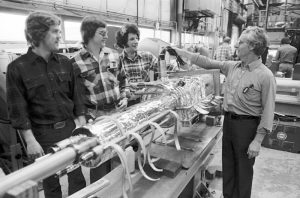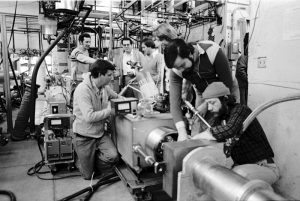The Muon g-2 experiment has begun its search for phantom particles with its world-famous and well-traveled electromagnet.
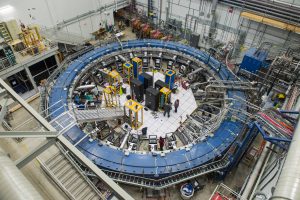
The Muon g-2 electromagnet at Fermilab, ready to receive a beam of muon particles. The ring generates a remarkably uniform magnetic field with which scientists will study properties of the muon in a hunt for undiscovered particles and forces. Photo: Fermilab
What do you get when you revive a beautiful 20-year-old physics machine, carefully transport it 3,200 miles over land and sea to its new home, and then use it to probe strange happenings in a magnetic field? Hopefully you get new insights into the elementary particles that make up everything.
The Muon g-2 experiment, located at the U.S. Department of Energy’s (DOE) Fermi National Accelerator Laboratory, has begun its quest for those insights. On May 31, the 50-foot-wide superconducting electromagnet at the center of the experiment saw its first beam of muon particles from Fermilab’s accelerators, kicking off a three-year effort to measure just what happens to those particles when placed in a stunningly precise magnetic field. The answer could rewrite scientists’ picture of the universe and how it works.
“The Muon g-2 experiment’s first beam truly signals the start of an important new research program at Fermilab, one that uses muon particles to look for rare and fascinating anomalies in nature,” said Fermilab Director Nigel Lockyer. “After years of preparation, I’m excited to see this experiment begin its search in earnest.”
Getting to this point was a long road for Muon g-2, both figuratively and literally. The first generation of this experiment took place at the U.S. DOE’s Brookhaven National Laboratory in New York state in the late 1990s and early 2000s. The goal of the experiment was to precisely measure one property of the muon – the particles’ precession, or wobble, in a magnetic field. The final results were surprising, hinting at the presence of previously unknown phantom particles or forces affecting the muon’s properties.
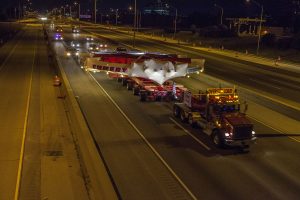
The Muon g-2 electromagnet on the road through Illinois to Fermilab in the summer of 2013. Photo: Fermilab
The new experiment at Fermilab will make use of the laboratory’s intense beam of muons to definitively answer the questions the Brookhaven experiment raised. And since it would have cost 10 times more to build a completely new machine at Brookhaven rather than move the magnet to Fermilab, the Muon g-2 team transported that large, fragile superconducting magnet in one piece from Long Island to the suburbs of Chicago in the summer of 2013.
The magnet took a barge south around Florida, up the Tennessee-Tombigbee waterway and the Illinois River, and was then driven on a specially designed truck over three nights to Fermilab. And thanks to a GPS-powered map online, it collected thousands of fans over its journey, making it one of the most well-known electromagnets in the world.
“Getting the magnet here was only half the battle,” said Chris Polly, project manager of the Muon g-2 experiment. “Since it arrived, the team here at Fermilab has been working around the clock installing detectors, building a control room and, for the past year, adjusting the uniformity of the magnetic field, which must be precisely known to an unprecedented level to obtain any new physics. It’s been a lot of work, but we’re ready now to really get started.”
That work has included the creation of a new beamline to deliver a pure beam of muons to the ring, the installation of a host of instrumentation to measure both the magnetic field and the muons as they circulate within it, and a year-long process of “shimming” the magnet, inserting tiny pieces of metal by hand to shape the magnetic field. The field created by the magnet is now three times more uniform than the one it created at Brookhaven.
Over the next few weeks the Muon g-2 team will test the equipment installed around the magnet, which will be storing and measuring muons for the first time in 16 years. Later this year, they will start taking science-quality data, and if their results confirm the anomaly first seen at Brookhaven, it will mean that the elegant picture of the universe that scientists have been working on for decades is incomplete and that new particles or forces may be out there, waiting to be discovered.
“It’s an exciting time for the whole team, and for physics,” said David Hertzog of the University of Washington, co-spokesperson of the Muon g-2 collaboration. “The magnet has been working, and working fantastically well. It won’t be long until we have our first results and a better view through the window that the Brookhaven experiment opened for us.”
The Muon g-2 collaboration includes more than 150 scientists and engineers from more than 30 institutions in nine countries.
Learn more about the Muon g-2 experiment.
The Muon g-2 experiment is supported by DOE’s Office of Science and the National Science Foundation.
Fermilab is America’s premier national laboratory for particle physics research. A U.S. Department of Energy Office of Science laboratory, Fermilab is located near Chicago, Illinois, and operated under contract by the Fermi Research Alliance LLC. Visit Fermilab’s website at https://www.fnal.govand follow us on Twitter @Fermilab.
The DOE Office of Science is the single largest supporter of basic research in the physical sciences in the United States, and is working to address some of the most pressing challenges of our time. For more information, please visit science.energy.gov.
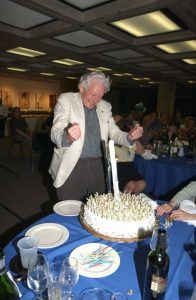
This photo of former director Leon Lederman celebrating his 80th birthday sums up our own birthday excitement.
As we hope you’ve heard, this year Fermilab is celebrating its 50th anniversary! We’re reaching out to friends, partners, employees past and present, and fans around the world to help us celebrate on June 15, the lab’s 50th birthday. We hope you’ll join us in wishing Fermilab a happy birthday. There are several ways to do this:
1) You can write your own message and share it on social media on June 15. Have fun! Share a picture of yourself at the lab, a gif, a video greeting with friends, a sign, or anything else you can think of. Use #Fermilabs50th or #HappyBirthdayFermilab so we can find and share your post – and so we can send one of our fans a 50th anniversary prize.
2) To make things extra simple, we’ve also set up a Thunderclap, which will automate posting a happy birthday message on June 15. Just sign up for the Thunderclap on Facebook or Twitter and this program takes care of the rest. (One note: this does ask for permission to post to your social media account, but will only use that access to post the “Happy birthday Fermilab” message, and nothing else.)
3) If you’re feeling extra ambitious, consider sending us some actual mail! We’re collecting birthday cards and will put them on display in the Wilson Hall atrium during our June 15 celebration at the lab. We’ll also share them on social media. You can mail cards to:
Fermi National Accelerator Laboratory
PO Box 500, MS 206
Batavia, Illinois 60510
Include your return address on your card’s envelope – we’ll be sending one lucky supporter a 50th anniversary prize.
4) Don’t forget to check Fermilab’s social media channels on June 15 for some fun surprises!
However you choose to celebrate, thank you for supporting the lab and for helping us make it a great 50 years. We look forward to the next 50 years of discovery and innovation!
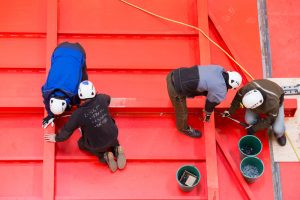
Technicians assemble for ICARUS the warm vessel steel structure that will host two detection chambers. Photo: Reidar Hahn
No fewer than three particle physics laboratories lay claim to some aspect of the detector, called ICARUS, that will soon become the newest member of Fermilab’s neutrino family. The Italian INFN Gran Sasso National Laboratory took data using the 760-ton, 65-foot-long detector for its ICARUS experiment from 2010 to 2014. The European laboratory CERN sent beam to the detector when it was at Gran Sasso. And Fermilab is soon to inherit the detector for its Short-Baseline Neutrino Program. Fermilab is currently awaiting the detector’s arrival from CERN, where staff have been refurbishing it for use in the SBN Program.
So it is fitting that technicians, led by Frederic Merlet of CERN, from the two European laboratories recently converged at Fermilab to work with the U.S. ICARUS team, led by Fermilab’s David Augustine.
During the visit, which took place from May 1-21, the technicians assembled the steel structure that will host the detector’s two 300-ton time projection chambers.
“They accomplished this amazing task with absolutely superb work ethic and cooperation,” said Fermilab physicist Fernanda G. Garcia, who is the project installation and integration manager. “The installation went smoothly thanks in great part to Dave and Frederic’s leadership skills.”
It was not only just technicians, but also machinists, quality and safety personnel, business administrators, and transportation coordinators who came together to prepare the detector’s future home.
The contributions of our trans-Atlantic partners at CERN and INFN demonstrate once more that the science of particle physics is a global pursuit.
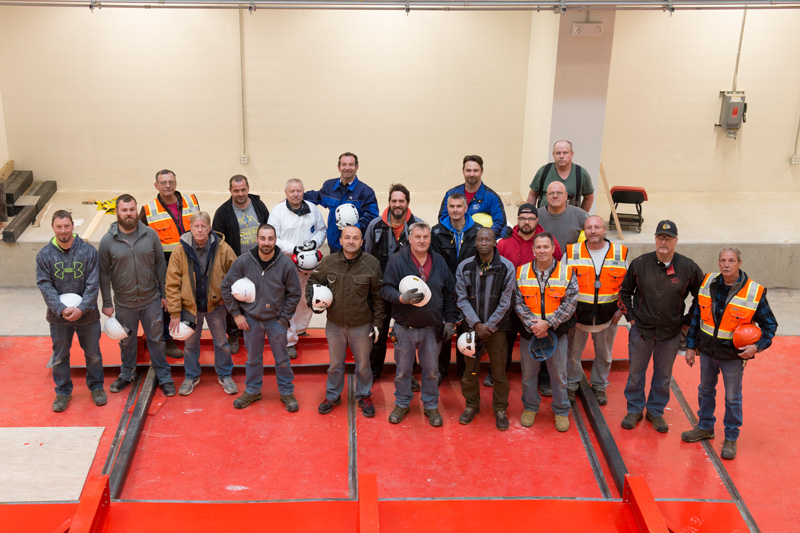
Thanks to the CERN, Fermilab and INFN crew for paving the way for ICARUS. First row, from left: John Anderson III, Justin Briney, Ben Ogert, Daniel Vrbos (all Fermilab), Marco Guerzoni (INFN), David Augustine (Fermilab), Vincent Togo (INFN), Timothy Griffin, Thomas Olszanowski, Michael Cooper (all Fermilab). Second row, from left: John Voirin (Fermilab), Francois-Andre Garnier, Anatoly Popov, Filippo Resnati, Frederic Merlet (all CERN), Jason Kubinski, Bob Kubinski (both Fermilab). Third row, from left: Pierre-Ange Giudici (CERN), Michael Jeeninga, Mark Shoun (both Fermilab). Not pictured: Joseph Harris, Kelly Hardin, Bryan Johnson and Craig Rogers, all of Fermilab. Photo: Reidar Hahn
When I started at the lab in December 1977, work on the dipole magnets for the Tevatron was well under way in what was then called the Energy Doubler Department in the Technical Services Section.
My first project was to work on the quadrupole magnets and spools, which hadn’t really been started yet. The spool is a special unit that attaches to each quadrupole and the adjacent dipole. It contains what we used to call “the stuff that wouldn’t fit anywhere else” – correction magnets and their power leads, quench stoppers to dump the energy from all the magnets, beam position monitors, relief valves, things like that.
At the time, we were located in the Village in the old director’s complex, which now houses the daycare center. We had a large open area where the engineers, designers and drafters worked and a small conference room where we kept up-to-date models of some of the things we were working on.
For several weeks we worked feverishly on the design of the quadrupole and spool combination — we in the design room and the model makers in the model shop on their full-scale models. We would work all week, then have a meeting with the lab director, Bob Wilson. Dr. Wilson would come out to see how we were doing, but more importantly to see what our designs looked like.
It turns out he was very interested in that and very fussy that things — even those buried in the tunnel — looked just so.
After every one of those meetings we’d walk back into the design room and tell everyone to tear up what we’d been working on and start over. The same would hold for the model makers. This went on for several weeks until Dr. Wilson was happy. We began to really dread going into those meetings, but in the end they served us very well.
Tom Nicol is a mechanical engineer at Fermilab.
Para una versión en español, haga clic aquí. Para a versão em português, clique aqui. Pour une version en français, cliquez ici.
Neutrinos are the most abundant elementary particles in the universe that weigh something. They have no electric charge, and they pass through almost everything since they interact only weakly with matter. There are three types of neutrinos, and they change from one type into another other as they travel, a behavior called oscillation. Physicists have been engaged for years in measuring how much and how often neutrinos oscillate between their various types.
Our understanding of the process crucially depends on the measurement of the neutrino energy. We cannot measure the energy of the neutrinos themselves; we can measure only the energies of the particles that are produced by the interaction of a neutrino with the detector, typically made of material of heavy nuclei, which enables lots of interactions and so opportunities for observing the neutrino’s behavior. The nuclear environment is a complicated one, so making measurements is a difficult task.
We need a detailed understanding of the neutrino’s interaction inside the nucleus to precisely measure its energy. In the energy range of many oscillation experiments, the dominant interaction process is one in which a neutrino completely scatters off a neutron inside the nucleus and produces a muon and proton. The produced proton can interact further with other particles inside the nucleus. Thus in the presence of other protons and neutrons, the distributions of the final-state particles may differ from the primary interaction.
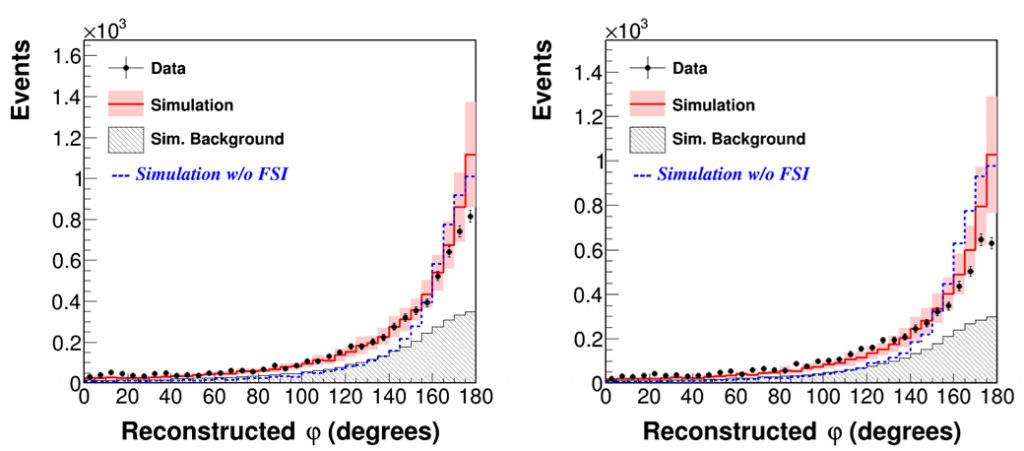
These plots show the angle between the plane of the neutrino-proton interaction and that of the neutrino-muon interaction for iron (left) and left (right).
One way to see how the nucleus changes the picture is to look at the angle between two planes that define the interaction: If you think of the plane that includes the neutrino direction and the proton direction, and also the plane that includes the neutrino direction and the muon direction, those two planes should be “back to back,” or different by 180 degrees. MINERvA can measure the angle between those two planes precisely. It turns out that these events are not all at 180 degrees apart — not even close.
If you are a teacher, you have to deal with this kind of situation every day. Suppose you supervise a large group of kids, and you know the individual behavior of each kid. However, when they are in a large group, each kid’s behavior is affected by others, so you adjust your prediction. The behavior of a kid in a group will be different from her behavior when she is by herself.
Think of the proton and neutrons as the kids, which are inside a bound nucleus. Your estimation of how much energy the kids have will be different once you take into account the fact that they are losing lots of energy interacting with each other, compared to when they were just sitting in separate rooms by themselves.
MINERvA recently made a new measurement of this process by including all the events with a muon plus at least one proton and no lighter particles. The probability of a neutrino interaction is measured as a function of momentum transferred to the nucleus (called “Q2”), which is calculated using a measurement of the proton’s energy.
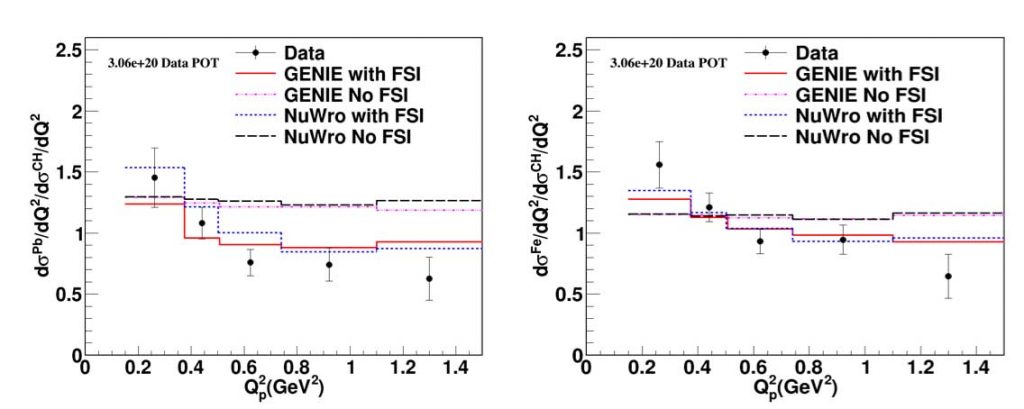
These graphs show the ratio between the cross section on lead (left) and iron (right) to the cross section on hydrocarbon (plastic).
MINERvA carried out the measurement simultaneously on carbon, iron and lead. A previous MINERvA study measured this process on plastic (hydrocarbon) alone.
If all the kids in the nucleus behaved like individuals, then the ratio of cross sections would be close to a constant that’s related to ratio of the fraction of neutrons in each target nucleus. But these ratios are not at a constant value, as you can see in the plots.
This measurement also shows that the dependence on the target element (lead or iron) is not well-described in the current nuclear models and that the theorists have some homework to do before the predictions for experiments measuring oscillations will be precise. This is the first time a direct measurement of this has ever been made. This result was submitted for publication last week.

These physicists lead this analysis: Minerba Betancourt (left) and Tammy Walton (middle) of Fermilab, and Anushree Ghosh (right) of Federico Santa María Technical University.
Anushree Ghosh is a postdoctoral researcher at Federico Santa María Technical University.

